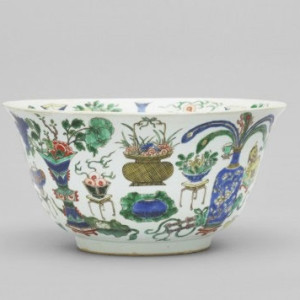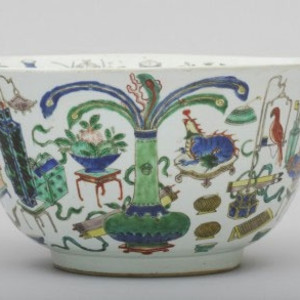Of round form, the deep sides rising from a short foot to a flaring rim, brightly and finely painted in famille verte enamels with a decoration of the Hundred Antiquities covering the exterior sides and continuing on the interior on the central roundel and as a broad band around the interior rim, amongst the various vases, stands, incense holders, peacock feathers and coral, some of the objects that occupy this pattern, nestles a falcon chained to its elaborate stand, a small mythological beast with the head of a phoenix and the body of a kylin on a low stand and a white hare on a green Artemisia leaf, the base glazed and painted in the centre with a stylized fungus in blue inside double circular blue lines.
Literature
The Hundred Antiquities is a miscellaneous or general collection of emblematic forms comprising the Eight Treasures, the Four Treasures, the symbols of Four Fine Arts (music, chess, calligraphy and painting) together with numerous conventional representations of sacrificial vessels flowers and animals.
Some of the objects that appear on our bowl have the following symbolism:
Books - symbols of learning and one of the Four Signs of a Scholar.
Brush Holder - scholarly attainments.
Brushes - one of the Four Signs of a Scholar.
Checkering - chess, symbols of learning and one of the Four Signs of a Scholar.
Flowers - beauty and harmony.
Incense Burner - ancestral worship.
Palm leaf (Chiao Yeh) - self education.
Peacock Plumes - represent official rank.
Scepter - symbol of Buddha, magical powers, prosperity.
Scrolls - calligraphy, painting and truth.
Tripod - filial piety, an ancient ritual vessel.
Vase Ping - Symbol for peace since the word 'vase' in Chinese sounds much like the word for 'peace', as a receptacle it is a Daoist symbol for the female principle.




